When powering your tiny house with fuel cells, start by choosing the right type and size for your energy needs. Guarantee proper installation in a well-ventilated area and follow safety protocols, including carbon monoxide detection. Manage fuel storage efficiently and consider integrating renewable energy sources like solar panels. Optimize your energy consumption with efficient appliances and smart power management. Don't forget to comply with local regulations and obtain necessary permits. Regular maintenance is essential for longevity and performance. By implementing these tips, you'll create a reliable and eco-friendly power system for your tiny home. Dive deeper to access the full potential of fuel cell technology in your compact living space.
Choose the Right Fuel Cell
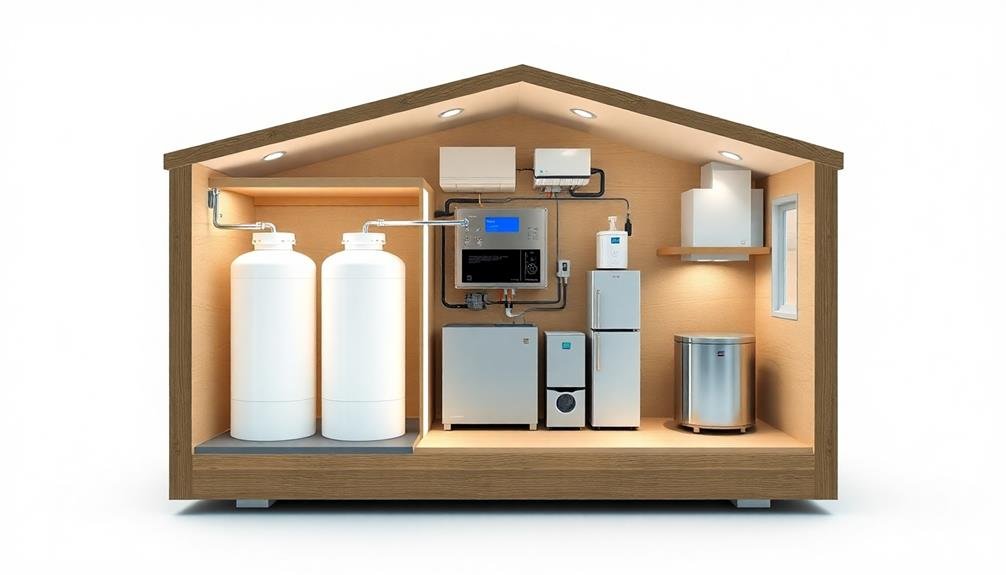
How do you select the perfect fuel cell for your tiny house? Start by evaluating your power needs. Calculate your daily energy consumption, factoring in appliances, lighting, and electronics. This will help determine the required wattage output for your fuel cell.
Consider the fuel type. Hydrogen fuel cells are clean and efficient but require a reliable hydrogen source. Methanol fuel cells are more accessible but less powerful. Natural gas fuel cells offer a good balance of power and availability.
Size matters in a tiny house. Look for compact fuel cells that fit your limited space. Some models are designed specifically for small-scale applications.
Don't forget about noise levels. Choose a fuel cell with low decibel ratings to maintain your peaceful tiny house environment.
Examine the fuel cell's efficiency and durability. Higher efficiency means lower fuel costs, while durability guarantees long-term reliability.
Check for safety features like automatic shutoffs and ventilation systems. Proper installation and maintenance are vital for safe operation.
Lastly, consider your budget. While fuel cells can be expensive upfront, factor in long-term savings on energy costs. Look for models that offer the best value for your specific needs.
Calculate Your Energy Needs
To accurately size your fuel cell system, you'll need to calculate your tiny house's energy requirements.
Start by evaluating your daily power consumption, listing all appliances and devices you use regularly and their wattage.
Next, determine your peak energy needs by considering times when multiple high-draw appliances might run simultaneously, ensuring your fuel cell can handle these demands.
Assess Daily Power Consumption
Calculating your daily power consumption is an essential step in determining the right fuel cell system for your tiny house. To accurately assess your energy needs, start by listing all the electrical appliances and devices you'll use regularly. Include everything from lighting and refrigeration to entertainment systems and charging devices.
Next, find the wattage rating for each item. You'll often find this information on the appliance itself or in its manual. Multiply the wattage by the number of hours you expect to use the device each day. This gives you the daily watt-hours for that item. Add up the watt-hours for all your appliances to get your total daily energy consumption.
Don't forget to account for seasonal variations and occasional high-demand activities. Consider using energy-efficient appliances to reduce your overall consumption. It's also wise to add a 20% buffer to your calculations to guarantee you're not underestimating your needs.
Once you've determined your daily power consumption, you can more effectively choose a fuel cell system that meets your tiny house's energy requirements without unnecessary excess capacity or insufficient output.
Determine Peak Energy Requirements
Pinpointing your peak energy requirements is essential when sizing a fuel cell system for your tiny house. To determine these requirements, you'll need to identify the appliances and devices that draw the most power simultaneously.
Start by listing all your high-wattage items, such as air conditioners, heaters, and cooking appliances.
Next, consider when you're likely to use multiple power-hungry devices at once. For example, you might run your microwave and electric kettle while the refrigerator cycles on. Add up the wattage of these devices to calculate your peak load.
Don't forget to account for startup surges, which can be several times higher than running wattage for motors and compressors.
Factor in any future additions to your tiny house, like extra lighting or a home office setup. It's better to overestimate slightly than underestimate your needs.
Once you've determined your peak energy requirements, add a 20% buffer for safety and unexpected usage. This final figure will guide you in selecting the right fuel cell capacity to guarantee your tiny house has sufficient power during high-demand periods without overloading the system.
Proper Installation and Placement
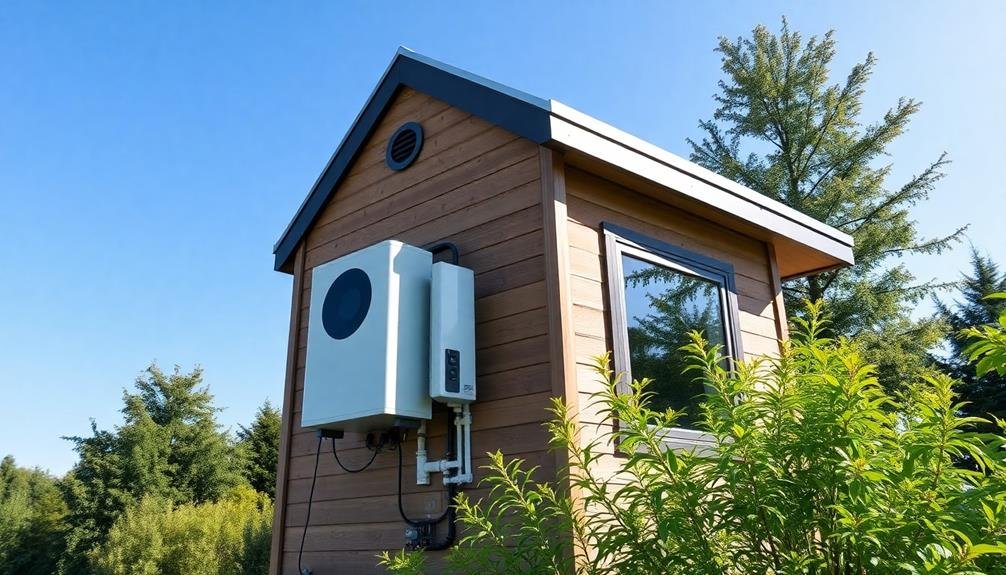
The proper installation and placement of fuel cells in tiny houses is vital for safety and efficiency. You'll need to choose a well-ventilated area, preferably near an exterior wall, to guarantee proper exhaust. It's essential to keep the fuel cell away from living spaces and heat sources.
When installing, make certain you have the necessary permits and follow local building codes. You'll want to place the fuel cell on a stable, level surface that can support its weight. Consider using a vibration-dampening pad to reduce noise and vibrations.
Proper ventilation is key. Install intake and exhaust vents according to the manufacturer's specifications. You'll need to route exhaust pipes outside, away from windows and doors.
Don't forget to install carbon monoxide detectors in your tiny house as an added safety measure.
For fuel storage, use appropriate tanks and place them in a separate, well-ventilated area. Maintain easy access for maintenance and refueling.
You'll also need to plan for electrical connections, including proper wiring and a transfer switch if you're connecting to the grid.
Lastly, consider soundproofing measures to minimize noise from the fuel cell, especially if it's near sleeping areas.
Ventilation and Safety Measures
When installing a fuel cell in your tiny house, prioritize ventilation and safety measures.
You'll need to set up a proper exhaust system to expel harmful gases and install carbon monoxide detectors in key areas.
Don't forget to schedule regular maintenance checks to guarantee your fuel cell operates safely and efficiently.
Proper Exhaust System Installation
Invariably, proper exhaust system installation stands as a critical safety measure for fuel cells in tiny houses. You'll need to guarantee that exhaust gases are safely vented outside your living space to prevent carbon monoxide buildup. When installing your exhaust system, always follow the manufacturer's guidelines and local building codes.
Choose heat-resistant materials for your exhaust piping, such as stainless steel or specialized fuel cell exhaust tubing. Install the exhaust pipe with a slight upward slope to prevent condensation from flowing back into the fuel cell. Seal all connections tightly to prevent leaks, and use appropriate support brackets to secure the piping.
Here are three key considerations for your exhaust system:
- Length: Keep the exhaust pipe as short and straight as possible to minimize backpressure.
- Termination point: Guarantee the exhaust outlet is well away from windows, doors, and air intakes.
- Weather protection: Install a rain cap or hood to prevent water from entering the system.
Remember to regularly inspect your exhaust system for any signs of damage or corrosion.
Carbon Monoxide Detectors
Installing carbon monoxide detectors is an essential safety measure when using fuel cells in tiny houses.
You'll need to place these detectors strategically throughout your living space to guarantee early detection of any potential carbon monoxide leaks. Install at least one detector on each level of your tiny house, including sleeping areas and near the fuel cell system itself.
Choose battery-operated or hardwired detectors with battery backup to guarantee continuous protection, even during power outages. Opt for models with digital displays that show real-time CO levels and feature both visual and audible alarms.
You should test your detectors monthly and replace batteries annually or as needed.
Don't forget to familiarize yourself with the symptoms of carbon monoxide poisoning, which include headaches, dizziness, nausea, and confusion. If your alarm sounds or you suspect a CO leak, immediately evacuate your tiny house and call emergency services.
Regularly maintain your fuel cell system and ventilation to minimize the risk of CO buildup. By taking these precautions, you'll create a safer environment for yourself and any guests in your tiny house powered by fuel cells.
Regular Maintenance Checks
Diligence is key when it comes to regular maintenance checks for your fuel cell system in a tiny house.
You'll need to establish a routine inspection schedule to guarantee your system operates efficiently and safely. Start by familiarizing yourself with the manufacturer's guidelines for your specific fuel cell model, as maintenance requirements may vary.
During your regular checks, focus on these critical areas:
- Inspect all connections and hoses for signs of wear, leaks, or damage.
- Clean or replace air filters as recommended by the manufacturer.
- Check and top up water levels in the fuel cell, if applicable.
Don't forget to monitor your fuel cell's performance indicators, such as power output and efficiency.
If you notice any decline, it's time to investigate further. Keep a log of your maintenance activities and any issues you encounter, as this can help identify patterns or recurring problems.
Fuel Storage and Management
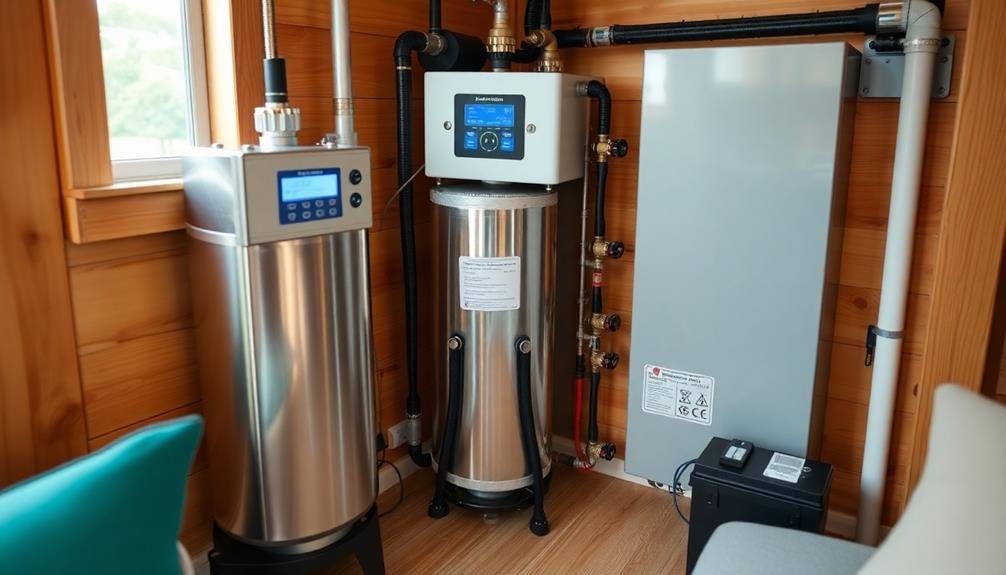
Proper fuel storage and management are vital for the safe and efficient operation of fuel cells in tiny houses. You'll need to carefully consider the type of fuel you're using and how to store it safely. For hydrogen fuel cells, you'll require a secure, well-ventilated area for hydrogen tank storage. If you're using methanol or propane, make sure you follow local regulations for storage and handling.
To manage your fuel efficiently, monitor your usage patterns and plan refills accordingly. Keep track of your fuel levels and schedule deliveries or refills before you run low. It's essential to maintain a backup power source in case of fuel shortages or system malfunctions.
Here's a quick reference guide for fuel storage and management:
| Fuel Type | Storage Requirements | Safety Precautions | Refill Frequency |
|---|---|---|---|
| Hydrogen | Pressurized tanks | Ventilation, leak detection | Weekly to monthly |
| Methanol | Sealed containers | Fire-resistant storage | Monthly to quarterly |
| Propane | Outdoor tanks | Regular inspections | Quarterly to annually |
| Natural Gas | Pipeline connection | Leak detection system | Continuous supply |
Maintenance and Cleaning Routines
Regular upkeep is vital for keeping your fuel cell system running smoothly in your tiny house. Establish a routine maintenance schedule to guarantee peak performance and longevity of your fuel cell. This includes regular inspections, cleaning, and replacing components as needed.
Clean the fuel cell stack periodically to remove any dust or debris that may have accumulated. Use a soft, lint-free cloth and a mild cleaning solution recommended by the manufacturer. Be sure to turn off the system and allow it to cool before cleaning.
Monitor and maintain proper water levels in the fuel cell, as water is essential for the electrochemical reaction. Check for any leaks or damage to the system's components, such as hoses, valves, and connections.
Here's a quick maintenance checklist:
- Inspect air filters monthly and replace as needed
- Check and tighten electrical connections every six months
- Test the backup battery annually and replace if necessary
Combining With Renewable Energy Sources
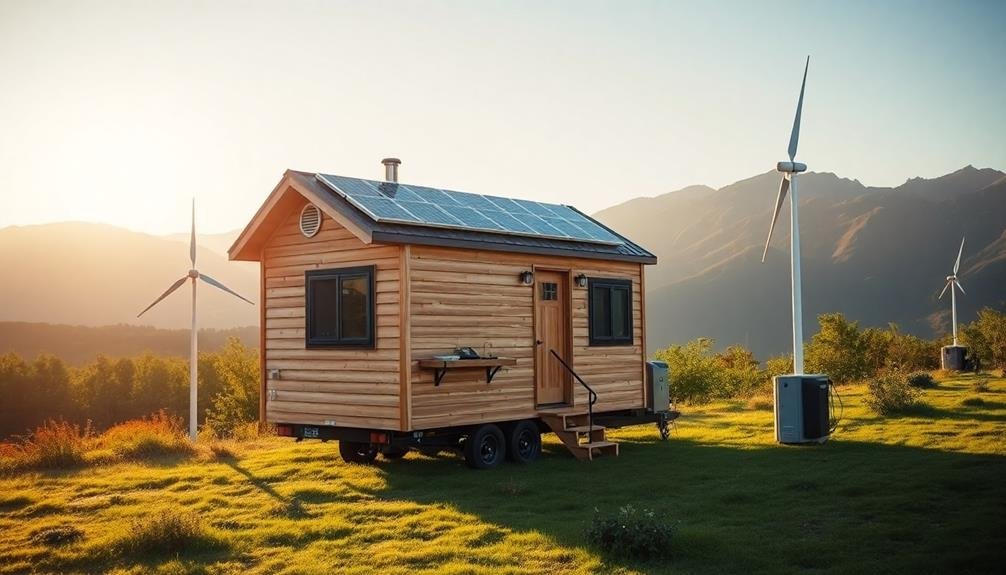
To maximize energy efficiency in your tiny house, consider pairing your fuel cell system with renewable energy sources.
Solar panels are an excellent complement to fuel cells, as they can generate electricity during daylight hours while your fuel cell provides consistent power at night or on cloudy days. Install photovoltaic panels on your tiny house's roof or use portable solar panels for flexibility.
Wind turbines can also work well with fuel cells, especially if you're in an area with consistent wind patterns. Small vertical-axis wind turbines are often suitable for tiny houses, as they're compact and can operate in variable wind conditions.
Combine these with your fuel cell to create a robust, off-grid power system.
Micro-hydro systems are another option if you're near a flowing water source. These can provide a steady stream of renewable energy to supplement your fuel cell.
When integrating these renewable sources, use a smart energy management system to optimize power distribution and storage. This will help you balance the various energy inputs and guarantee your tiny house always has sufficient power, while minimizing waste and maximizing efficiency.
Optimize Energy Consumption
To optimize energy consumption in your tiny house fuel cell system, focus on reducing standby power usage.
You can start by unplugging devices when not in use and using smart power strips to eliminate phantom loads.
Additionally, implement energy-efficient appliances throughout your tiny home to minimize overall power consumption and maximize your fuel cell's effectiveness.
Reduce Standby Power Usage
Your tiny house's fuel cell efficiency can be greatly improved by reducing standby power usage.
Standby power, also known as vampire power, is the electricity consumed by devices when they're not in active use but still plugged in. In a tiny house, where every watt counts, eliminating this waste is essential for maximizing your fuel cell's performance.
To reduce standby power consumption, start by identifying the culprits. Common offenders include chargers, entertainment systems, and kitchen appliances.
Once you've pinpointed these energy vampires, take action to minimize their impact. Here are three effective strategies:
- Use smart power strips to automatically cut power to devices when they're not in use
- Unplug appliances and chargers when they're not needed
- Opt for Energy Star certified devices that consume less standby power
Implement Energy-Efficient Appliances
After tackling standby power consumption, the next essential step in optimizing your fuel cell's efficiency is implementing energy-efficient appliances.
Start by replacing your old refrigerator with an ENERGY STAR certified model, which can use up to 15% less energy. Opt for LED lighting throughout your tiny house, as these bulbs consume 75% less energy than traditional incandescent ones.
Consider investing in a heat pump for both heating and cooling, as it's more efficient than separate systems. When it comes to cooking, induction cooktops are highly efficient and pair well with fuel cell systems.
For laundry, choose a front-loading washing machine and a heat pump dryer, both of which use considerably less energy than their conventional counterparts.
Don't forget about your water heater – tankless models are ideal for tiny houses and can reduce energy consumption by up to 34%.
Install a programmable or smart thermostat to automatically adjust your home's temperature based on your schedule.
Finally, when selecting any appliance, always check its energy rating and opt for the most efficient models within your budget.
Backup Power Solutions

A tiny house's backup power solution is fundamental for maintaining comfort and functionality during grid outages or off-grid living. When evaluating fuel cells as your backup power source, you'll need to assess your energy needs and choose the right size system. Most fuel cells for tiny houses range from 1kW to 5kW, providing enough power for essential appliances and lighting.
To guarantee your fuel cell backup system is effective, follow these steps:
- Calculate your daily energy consumption
- Determine the duration of backup power needed
- Select a fuel cell system that meets your requirements
You'll also need to examine fuel storage and accessibility. Hydrogen fuel cells are becoming increasingly popular due to their clean emissions and efficiency.
However, propane fuel cells might be more practical for some tiny house owners due to easier fuel availability.
Don't forget to integrate your fuel cell with your existing power system. Many fuel cells can work in conjunction with solar panels and batteries, providing a detailed energy solution for your tiny house.
Regular maintenance and proper ventilation are vital for the longevity and safety of your fuel cell system.
Regulations and Permits
Maneuvering the regulatory landscape for fuel cell installations in tiny houses can be challenging.
You'll need to familiarize yourself with local, state, and federal regulations governing fuel cell use in residential settings. Start by contacting your local building department to inquire about specific requirements for tiny houses and fuel cell systems.
You'll likely need to obtain permits for both the fuel cell installation and the tiny house itself. Be prepared to submit detailed plans, including electrical schematics and fuel cell specifications.
Many jurisdictions require inspections at various stages of the installation process, so factor this into your timeline.
Safety is a primary concern for regulators. You'll need to demonstrate that your fuel cell system meets all applicable safety standards, including proper ventilation and emergency shut-off mechanisms.
Some areas may require additional safety features, such as gas detectors or fire suppression systems.
Zoning laws can also impact your fuel cell installation. Check if there are restrictions on fuel storage or power generation in your area.
You might need to seek variances or special permissions if your tiny house doesn't fit typical residential classifications.
Frequently Asked Questions
How Long Does a Typical Fuel Cell Last in a Tiny House?
You'll find that a typical fuel cell in your tiny house can last anywhere from 5 to 15 years, depending on usage and maintenance. It's important to follow the manufacturer's guidelines to maximize its lifespan and efficiency.
Can Fuel Cells Power Air Conditioning Systems in Tiny Houses?
Yes, you can use fuel cells to power air conditioning in your tiny house. They'll provide enough electricity for most AC units. However, you'll need to guarantee your fuel cell's capacity matches your AC's power requirements for efficient operation.
What's the Noise Level of a Fuel Cell System for Tiny Houses?
You'll find fuel cell systems for tiny houses surprisingly quiet. They're generally less noisy than traditional generators, operating at around 40-60 decibels. That's comparable to a refrigerator hum, so you won't be disturbed while relaxing at home.
Are There Portable Fuel Cell Options for Traveling Tiny Houses?
You'll find portable fuel cell options for your traveling tiny house. They're compact, lightweight, and can run on propane or methanol. You'll enjoy quiet operation and long-lasting power while on the road. Just guarantee proper ventilation for safety.
How Do Fuel Cells Perform in Extreme Temperatures for Tiny House Living?
You'll find fuel cells perform well in extreme temperatures for tiny house living. They're efficient in cold weather, though you'll need to protect them from freezing. In hot conditions, they'll require proper ventilation to maintain peak performance.
In Summary
You've now got the essentials for powering your tiny house with fuel cells. Remember, it's all about choosing the right system, installing it safely, and managing your energy efficiently. Don't forget to combine it with renewables and have a backup plan. Stay informed about regulations and always prioritize safety. With these tips, you'll be well on your way to a sustainable, off-grid tiny house lifestyle. Embrace the freedom and eco-friendly living that fuel cells can offer!

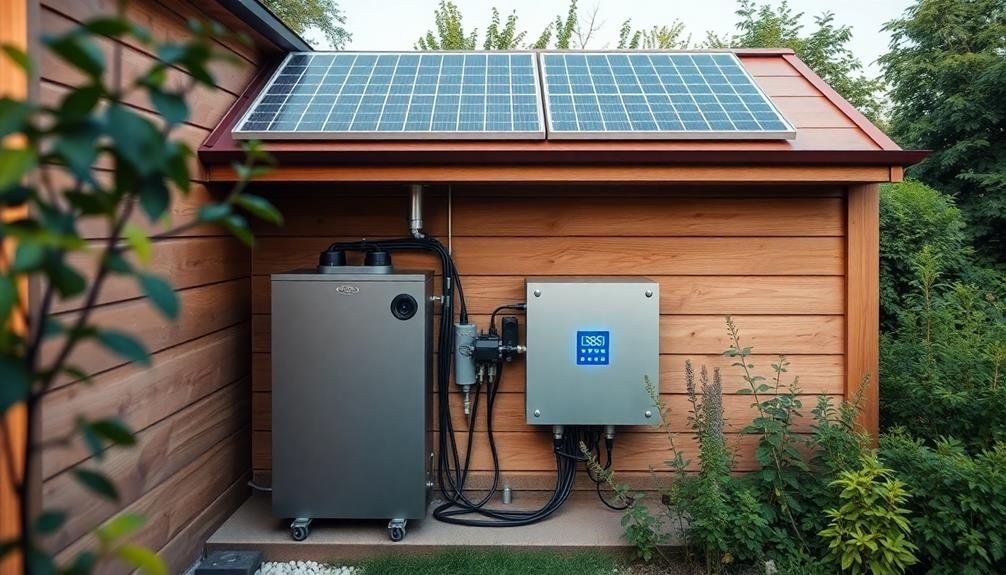

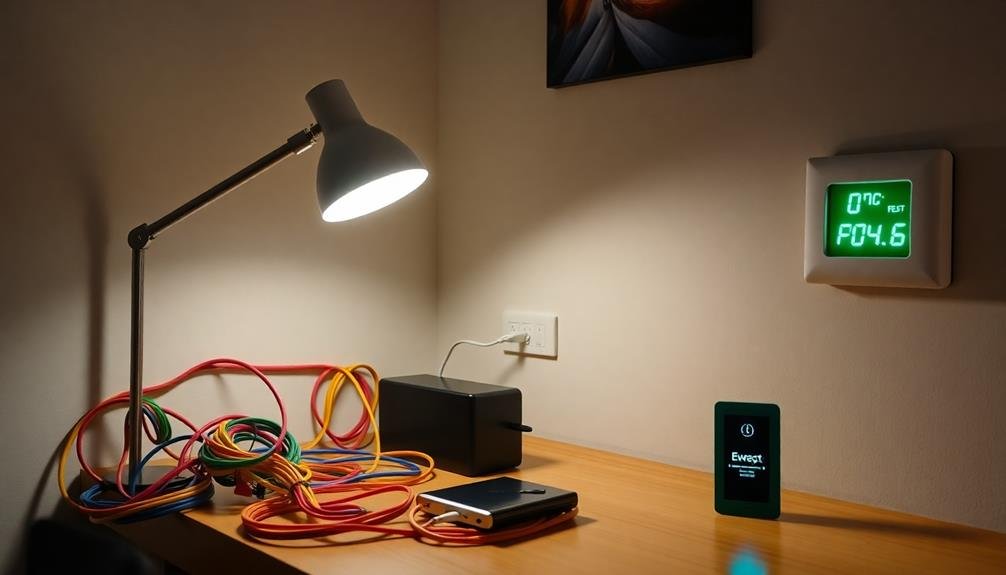
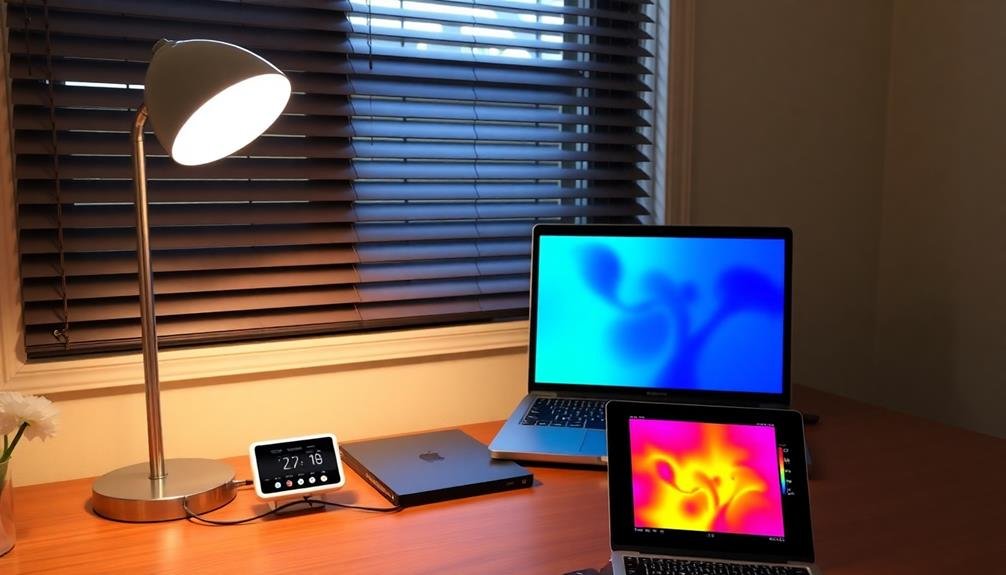
Leave a Reply